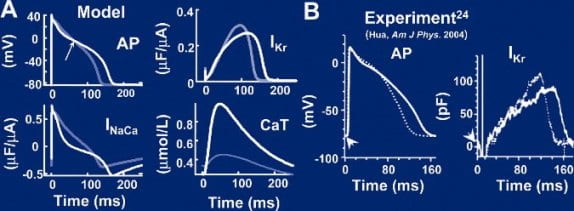Models and Simulations > Ion Channels | Cardiac Cells | Cardiac Tissue
Hund-Rudy Canine Ventricular Model: Action Potential and Calcium Transient Alternans
Livshitz LM, Rudy Y. “Regulation of Ca2+ and electrical alternans in cardiac myocytes: role of CAMKII and repolarizing currents” . Am J Physiol Heart Circ Physiol. 2007 Jun;292(6):H2854-66. Epub 2007 Feb 2.
Download: Matlab code for LRd; Matlab code for HRd

Alternans of cardiac repolarization is associated with arrhythmias and sudden death. At the cellular level, alternans involves beat-to-beat oscillation of the action potential (AP) and possibly Ca2+ transient (CaT). Because of experimental difficulty in independently controlling the Ca2+ and electrical subsystems, mathematical modelling provides additional insights into mechanisms and causality. Pacing protocols were conducted in a canine ventricular myocyte model with the following results: (I) CaT alternans results from refractoriness of the SR Ca2+ release system; alternation of the L-type Ca2+ current (ICa(L)) has a negligible effect; (II) CaT-AP coupling during late AP occurs through the Na+/Ca2+ exchanger (INaCa) and underlies APD alternans; (III) Increased Ca2+/calmodulin-dependent protein kinase II (CaMKII) activity extends the range of CaT and APD alternans to slower frequencies and increases alternans magnitude; its decrease suppresses CaT and APD alternans, exerting an antiarrhythmic effect; (IV). Increase of the rapid delayed rectifier current (IKr) also suppresses APD alternans, but without suppressing CaT alternans. Thus, CaMKII inhibition eliminates APD alternans by eliminating its cause (CaT alternans), while IKr enhancement does so by weakening CaT-APD coupling. The simulations identify combined CaMKII inhibition and IKr enhancement as a possible antiarrhythmic intervention.